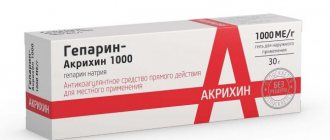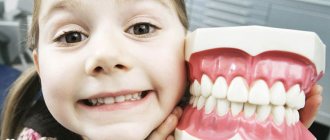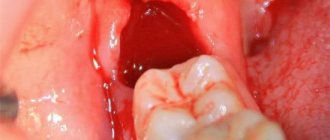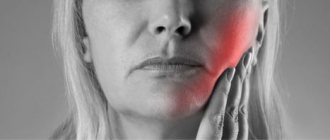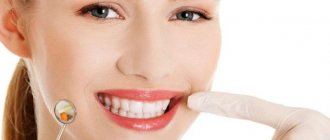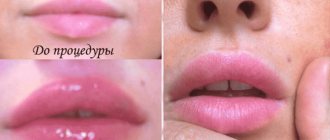The most common form of jaw injury is a bruise. No one is immune from this. For example, with a strong blow to the jaw, soft tissues, blood vessels, and capillaries are affected, resulting in the formation of hematomas and swelling. This is accompanied by severe pain and discomfort.
To avoid complications, it is recommended to consult a doctor immediately after injury. The fact is that impaired jaw function entails a chain of negative consequences: difficulties while eating, deterioration in the quality of spoken speech, etc.
What causes bruises?
Jaw injury may result from:
- falls;
- blow;
- fights;
- children's games;
- accidents, etc.
The severity of the injury is determined taking into account the following factors:
- features of the surface or object that caused the injury;
- impact intensity;
- affected area of the face;
- condition of bone tissue before the incident.
The strength of the bruise and possible complications depend on the listed indicators. Regardless of the severity, it is important to see a doctor to evaluate the condition and prescribe appropriate treatment. This will avoid unforeseen consequences and quickly restore the damaged area.
Diagnostic measures
If minor injuries to the maxillofacial area occur, they do not require contact with a dentist or surgeon, or urgent hospitalization. If there is severe and prolonged pain, the area of damage should be examined by a specialist.
The following are used as diagnostics:
- taking anamnesis;
- general examination by a surgeon, orthopedic dentist, traumatologist;
- special examination by an otolaryngologist, neurologist and other specialized specialists as necessary;
- X-ray examination of the maxillofacial area;
- CT scan;
- analysis of blood, urine, saliva.
Based on the data obtained, a general picture of the victim’s health is formed and a specific treatment is recommended.
The main therapeutic direction will be the following:
- taking painkillers;
- applying a pressure bandage;
- ensuring maximum peace for the victim;
- prescription of physiotherapeutic procedures;
- local and general anesthesia;
- elimination of hematoma and infiltrate.
Clinical picture
First of all, the doctor conducts a visual examination of the bruised area to identify hidden injuries that cannot be identified by a person without medical education. For example, symptoms of dislocations or fractures may not appear immediately. Professional consultation allows you to begin timely treatment, if required.
To recognize a jaw bruise, it is important to pay attention to the following symptoms:
- severe pain in the place where the blow fell, intensifying when pressed;
- visual signs (eg, swelling, redness, abrasions, bruises);
- limitation of jaw mobility when yawning, talking, chewing;
- inflammation of the lymph nodes;
- general weakness.
Jaw bruises are less dangerous than more severe injuries, so recovery is usually quick.
The doctor may order an x-ray or computed tomography to establish an accurate diagnosis. These studies will assess the condition of the internal tissues of the affected area.
A little anatomy
The most prominent part of the head is the jaw, so it is easier to hit. A direct blow to it leads to a sharp turn of the head, as a result of which the brain hits the wall of the skull. As a result, the brain stem and cerebellum, which are the body's balance control center, suffer. A person receives a concussion, which manifests itself in long-term or short-term loss of consciousness, confusion of thoughts and complete disorientation in space.
When a blow is struck to the lower jaw, the inner ear is damaged, which is not only an organ of hearing, but also of balance, so a person who has received such a blow often falls.
Primary treatment
A bruise can be diagnosed by external signs even before seeing a doctor. To eliminate pain and discomfort, it is recommended to perform the following measures:
- apply a tight bandage;
- Apply a cold compress to the bruised area.
For quick and painless treatment, the face must be at rest. It is better to avoid warming compresses, as they can lead to the development of inflammatory processes.
The consequences of bruises can be such conditions as fractures, fractures, dislocations of the hard tissues of the jaw and even a concussion. Treatment differs depending on each case, so you should not self-medicate. It is also worth noting that most injuries have similar symptoms, so they are easy to confuse. Only a doctor can make a correct diagnosis. If you cannot go to the hospital yourself, it is recommended to call emergency medical help.
Medical care for jaw injuries
There is no specific treatment plan in such cases. But there is a list of general recommendations. Visits to the doctor are usually limited to one visit to evaluate the x-ray or CT scan.
If the patient escaped with an ordinary bruise, then treatment will be carried out at home. The patient will be given a bandage to hold the bones in the correct position. As mentioned above, you need to apply cold compresses. Ice, snow, and sterile gauze moistened with cold water are suitable for these purposes. Warming the affected area is contraindicated to avoid inflammation and worsening the clinical condition.
To eliminate pain, taking analgesics is allowed. Following simple rules will allow you to quickly get rid of the consequences of a bruise and return to your normal life.
Likely consequences
Any injury with negligence and non-compliance with medical recommendations can lead to all sorts of complications. If we talk about a bruise of the jaw, then it can develop into a post-traumatic form of periostitis, myositis or deformation of bone tissue. Any complications will require lengthy and likely expensive treatment. Injury to the masticatory muscles can cause limited mobility of the lower jaw, complicate chewing and swallowing, which directly affects the state of the gastrointestinal tract and metabolic functions of the body.
What happens to the brain after a blow to the jaw?
The human brain is very fragile. Any, even the most minor, blows to the head lead to damage. A blow to the jaw is the most dangerous for him. Let's tell you why and explain it using the example of Archimedes' law.
The brain is located in the upper part of the skull, and the jaw is a lever that allows you to move the brain off its axis without much effort. If its slight displacement causes discomfort, then a strong shake leads to a concussion. its source is precisely a blow to the jaw. Moreover, it does not matter with what force it was applied, since in this case it acts as a lever. According to the principle of Archimedes' law, using a longer lever allows you to apply less force.
Immediately after a blow to the jaw, the walls of the skull will begin to shift sharply to the side, while the brain will still remain in place. Then he will begin to move with them by inertia, but will lag behind them, as a result of which he will hit the protective walls. The resulting injuries lead to a concussion. This is where its protective function comes into play, the main goal of which is to “reboot” all body systems. It is at this moment that loss of consciousness occurs, and the brain becomes most vulnerable. If during the period of its “reboot” a person hits his head, he may fall into a coma.
First aid and treatment of bruises
Ice pack on problem area
Once the location of the damage has been identified, it is necessary to begin simple manipulations. Of course, they will depend on the nature of the damage. If there are open wounds, first of all they must be washed and treated with antiseptic.
Suitable products for this include hydrogen peroxide, Chlorhexidine, Miramistin, Bepanten. Before applying the antiseptic, the wound can be washed with soapy water. The bleeding area must be covered with a clean cloth or, if available, a sterile bandage.
Then apply cold to the affected area through the cloth. This can be an ice pack or a regular towel soaked in cold water, which is applied through a waterproof film.
For severe pain, the following medications are recommended by mouth:
- Analgin;
- Ketorol;
- Nurofen;
- Sedalgin;
- Nise;
- Took;
- Tempalgin;
- Nemesis.
Possible consequences
A bruise is not usually considered a serious injury. However, if you neglect the necessary treatment, unpleasant consequences arise. For example, the result of a bruise of the lower jaw can be a violation of the depreciation of muscle fibers, changes in the cartilage tissue of the joint and a speech defect.
On the muscle side, post-traumatic myositis develops as a complication. It is an inflammatory process, which is subsequently difficult to respond to therapeutic effects.
Attention!!! Bruises of various etiologies often become the cause of the formation of oncological tumors. Timely diagnosis and proper treatment can completely eliminate this complication.
With insufficient attention to the problem, jaw deformation, post-traumatic periostitis and even osteomyelitis occur. Abscesses and phlegmons may form in soft tissues. Such conditions require long-term therapy, with a long recovery period.
Injury to the maxillofacial area is not a trivial matter. It is worth treating this problem with increased attention. Of course, many of them go away on their own. However, ideally any injury should be examined by a medical professional.
Jaw displacement
One of the most common types of injuries is jaw displacement. The fact is that it is very easy to get such an injury, sometimes even unnoticed by yourself, for example, when actively chewing food or yawning. To avoid complications and surgery, it is better to treat a dislocated jaw immediately.
The lower jaw is connected to the temporal bone by two joints, the heads of which fit into the articular fossae. This gives us the ability to talk, chew and perform other movements. Signs of a dislocated jaw appear instantly, so the problem is easily diagnosed. When the heads pop out of the articular sockets, the jaw “jams” in the open position. This is accompanied by pain in the temporal bone area.
Causes of jaw dislocation
Displacement of the lower jaw occurs for the following reasons:
- sudden movement of the jaw in the process of chewing food, laughing, yawning, screaming;
- physical impact, for example, from a fall, impact;
- unprofessional reduction of the joint - if the person tried to solve the problem on his own;
- diseases of the skeletal system and joints, such as arthritis, arthrosis, rheumatism;
- displacement due to constant excessive load on the jaws;
- congenital anomalies of the temporomandibular joint;
- opening hard packages with teeth.
How to understand that a shift has occurred
Jaw displacement is difficult to miss. Dislocation can be anterior, posterior, unilateral or bilateral. The degree of complexity of a dislocation depends on the type of injury and is expressed by the following signs:
- with anterior displacement (when the jaw moves forward), the mouth freezes in an open position, pain appears in the parotid area, profuse salivation begins, and the proportions of the lower part of the face are disturbed;
- if the dislocation is posterior (the jaw goes back), then in addition to sharp pain, it becomes difficult for the person to breathe and swallow saliva, and it is almost impossible to open the mouth;
With complicated dislocations, bleeding from the ears, hematomas in the parotid area and swelling in the joint area are possible.
How to diagnose a dislocation
An experienced doctor can easily diagnose jaw displacement using a general examination and palpation. But in order to exclude the possibility of a fracture and make the most accurate diagnosis, an X-ray examination is prescribed, as well as a computed tomography or MRI of the joint.
How to treat jaw misalignment
In most cases, dislocation is treated by manual reduction. There are several methods of treating trauma: the Hippocratic method, the Blechman method, the Popescu method and a number of others. The exact method to treat a dislocation is determined only by the doctor, depending on the specific case. The jaw realignment procedure is carried out as follows:
- The patient takes a comfortable semi-lying position so that his face is at the level of the doctor’s forearm.
- The doctor places his thumbs on the teeth and clasps the jaw from below with the rest.
- By carefully applying pressure, the specialist returns the jaw to its original position.
- As a result, the head of the joint returns to the fossa. A characteristic click occurs and the patient reflexively closes the jaw. This indicates that the problem has been resolved.
Immediately after the jaw is realigned, it is fixed with a tight bandage, which must be worn for a week. For a complete recovery and to avoid relapse, it is necessary to abstain from rough food for a while and minimize stress on the joints. As a rule, the outcome of the procedure is favorable. But in case of old or complicated injuries, surgical intervention under local anesthesia is required.
